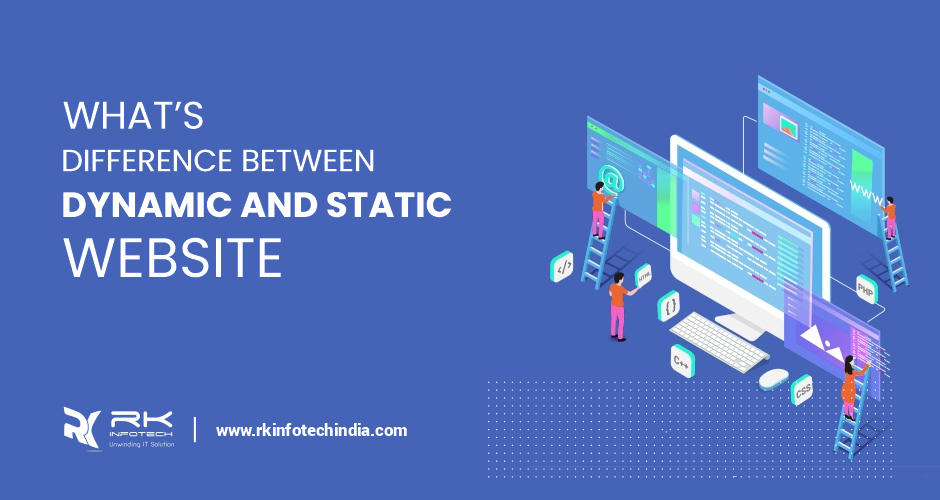What’s Difference between a dynamic and static website
Introduction
Dynamic and static website design. You probably have heard that they are the same. You might have also heard that they look the same. That is only because they aren’t! Dynamic websites are typically faster and load faster than static websites. They are also generally easier to customize and adjust for various devices like desktops, mobiles, tablets, and even old computers. Few things are as confusing to online marketers as static vs dynamic website designs. The confusion arises due to a lack of clarity over what exactly is meant by each term. Almost every website wants to look like a professional one.
Generally, static websites are used from business websites or portal sites. Usually, these websites have slightly less design and usually fewer features than their dynamic counterparts. On the one hand, there is the Dynamic Website. It enables the user to create its own website at any time, from another device in real-time – as if they were composing a post in WordPress! On the other hand, there is the static website, which is mainly used for administration purposes: checks and modifications of data.
Read More : The value of content before website design
What is a dynamic and static website?
These are the two ways you can think about web pages that are painted with a dynamic and static appearance. Dynamic websites are more fluid and responsive. A static website typically loads faster and doesn’t require as much processing power. Angular can display what you see in your browser without needing to download additional code, so you can start developing your app right away without waiting for it to download assets or waiting for it to start syncing with the server.
A Dynamic website is one in which the structure, coding, images, and other elements (such as Markup or schema markup) are constantly being updated to reflect the latest changes in the source data. A static website is one in which the data is stored in an unchanged state at the moment of loading. The advantage of a dynamic website over a static one would be the ability to react to changes instantly without needing to refresh the page. A static website is one where the structure and appearance of the site are not changed without a JavaScript or XML update.
A dynamic website is one that has changes made to the underlying web server which in turn make the site look different while loading faster and responsive on different devices. A static website and an interactive one are two very different types of websites. The static type is the one we are used to seeing on websites, whereas the interactive one offers additional features such as pop-up menus, video recordings, or polls. Both types of websites could be called static because they do not change their layout or appearance—they are static till the time they are converted into an interactive format.
There are many different types of dynamic websites that we come across on the Internet today. Thus, you can buy a static website that will eventually convert into an interactive form or vice versa. In web development, there is a difference between a dynamic website and a static one. A static website is one that simply looks as it would in the browser because it was coded correctly. However, a dynamic website will react to user actions and changes in the real world. This means that it may look different depending on where you are and what you are doing at that moment.
Difference between a dynamic and static website
It remains to be seen when you update your website, so there is no point in picking a time that’s outside your control. Always choose the time that works for you. A dynamic website is written in such a way that it changes on the fly. It can be changed from one script to another, or more important scripts or templates can be developed.
If you get updated content or plugins from different sources, for example, they will all work as if they were one seamless working document. The term “dynamic” website refers to a website that changes its appearance (for example, it uses customizations) or functionalities (for example, it may be set to automatically redirect visitors) depending on the contents or events that occur on the website.
Considered the most stable type of website, it is better for most users’ purposes. static site: The term “static” website refers to a static website that remains the same from the time its contents are loaded until the time they are viewed. Since it gives a predictable experience to its visitors, it may be suitable for some users. A static website is something that looks exactly the same each time you visit it. A dynamic website, on the other hand, keeps growing and changing based on the data it contains.
They have an all-new look that’s constantly being enhanced by an automation script or plugin. Everything from banner ads to featured content has been built to make the website load faster and always look fresh. This is why some call them front-end apps because they make the website experience so seamless.
There is a huge difference between a dynamic and static website, especially when it comes to SEO. If you are not familiar with it, then you are perhaps not aware that both of them are able to generate traffic and leads via search engines. If we want to get more visitors and leads on our website, the best approach is to use both types of them together.
However, if you are planning to start a website for your specific business from scratch and are not familiar with both, then you need to learn more about dynamic versus static websites. A dynamic website refers to one that automatically changes based on the number of clients, keywords, or other customizations without a user having to do anything.
A static website is one that uses links within the page to point to other pages. A static website might also feature a large header brimming with text advertising the content it contains, a navbar filled with buttons and sub-menus inside which are almost always dependent on the current page (e.g., product detail page), search form blocks (with limited functionality), images.
A static website is much easier to build and maintain than a dynamic one.It can also be more flexible and have a lot of customization options. However, this comes at a price; you cannot control what your visitors will see once they arrive on your site. On the other hand, a dynamic website is much more capable of giving you that customization option for whatever changes you want to make. That is why I usually prefer static websites over dynamic ones when building websites.
Which one should you choose: dynamic and static websites?
Web design is a very thrilling, creative, and challenging industry. The dynamic one is best for fighters who do not mind browsing through the pages during their free time (it’s very nice to jump into the configuration without having to wait for a website to load) but desire a more professional look and feel.
A dynamic website is a web design that changes depending on the time of day or week. A static site is a one-size-fits-all solution that looks the same from the browser’s perspective. This can make it harder to determine whether or not a static website is truly beneficial, or if it’s simply a waste of time.
There are a lot of wonderful static sites out there. They can look good, load fast and the design is professional, but they are very different from ones that are dynamic. If you’ve only heard about hosting a website or one that has a nifty admin panel, then maybe this is your type of blog. If you’re looking for something a bit more advanced with tons of features but still provide a great user experience then dynamic websites may be just what you’re looking for.
When starting to create or improve your website, the best way to think is as two specialized well-rounded solutions: static and dynamic. The construction of a website takes time, resources, and specialized skills. You need to engineer some parts right in the beginning and then gradually upgrade your existing static website with additional features once you have built your foundation.
It all depends on your project. If you are looking to build a website for a client and they need more customization features, then dynamic web design may be better for them but it is not required for a lot of projects.
If they just want the basic setup with some customized options, static web design is good enough. Both treatments have the potential to capture the attention of your target users. But, while static websites are more user-friendly, they lack creativity and interest.
Dynamic websites are able to catch the attention of new users. You should make sure that you’re choosing the treatment that will fulfill your project’s purpose.
Read More : what do you require website presences for your business?
Conclusion
Website design is a challenging and essential skill to have. A lot of moving pieces need to come together in a design, and it’s necessary to have flawless functioning of the website under any circumstance. You need to balance the need to maintain the functioning of your current servers with the reliable functioning of the website under new conditions such as increased traffic.
It is vital that you mix dynamic and static elements so that the functioning of your website looks as good as possible in all circumstances. This balance helps you attract and retain valuable traffic to your website.
Some people believe that static websites are easier to build, and therefore more attractive than dynamic ones. They’d be wrong if they thought that only an experienced coder could build a decent-looking website with only HTML. You can—and a host of tutorials show exactly how.
Static pages are fast loading, unblocked by in-page pages and ads, so your visitors can be assured that everything they see is new and fresh. You want to include all the things which will bring potential users to you.
And you want those potential users to come to your website with an open mind. This is something that can be increased greatly by the consistency of design elements – even if they are made of static elements such as images or HTML code. There are times when you might want a certain look and feel of your website only when it’s going live, and that is where custom graphic packs can help you out a lot.








